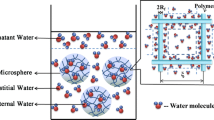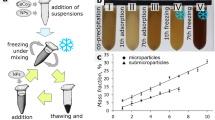Abstract.
Nuclear magnetic resonance (NMR) techniques have been successfully used to characterize the evolving pore structure of partially soluble pharmaceutical pellets as they absorb water and release soluble components. The restricted diffusivity of water trapped within pellets, which have been immersed in water for differing times, has been measured by pulsed field gradient NMR. These measurements have been used to calculate the surface-to-volume ratio and tortuosity of the pore structure. A one-shot Carr–Purcell–Meiboom–Gill sequence has been used to measure the spin–spin (T 2) relaxation time of water trapped within the pellets. These data have been regularized and then analyzed by the Brownstein–Tarr model to provide a pore size distribution for the pellets as a function of increasing immersion time. It has been found that pore structure changes significantly as water enters the pellet matrix. Two pellet formulations (herein referred to as placebo and drug-loaded) were studied and showed the same trends of a decreasing surface-to-volume ratio and tortuosity with increasing immersion time. At an immersion time of 10 min, both of these parameters decreased to approximately 70% of their values compared to an immersion time of 2 min. The placebo material tested consistently had both a higher tortuosity and surface-to-volume ratio than the drug-loaded material. At an immersion time of 2 min, the tortuosity for the placebo and drug-loaded materials were about 18 and about 10, respectively, and surface-to-volume ratios of about 6 μm−1 and about 5 μm−1, respectively. The materials tested also show changes in their pore size distribution with immersion time. In both formulations the mean and modal pore sizes increase with immersion time. The placebo material maintains an approximately similar mean and modal pore size, about 2 μm over the timescales studied, suggesting a more symmetric pore size distribution. In the drug-loaded pellets the mean pore size is much higher than the modal pore size, their values being 6.5 and 2.1 μm after 10 min immersion time, respectively.
Similar content being viewed by others
References
Brayden, D.J.: Drug Discov. Today 8, 976–978 (2003)
Graham, N.B.: Chem. Ind. 15, 482–486 (1990)
Langer, R.: Chem. Eng. Commun. 6, 1–48 (1980)
Shapiro, M., Jarema, M.A., Gravina, S.: J. Controlled Release 38, 123–127 (1996)
Fahie, B.J., Nangia, A., Chopra, S.K., Fyfe, C.A., Grondey, H.: J. Controlled Release 51, 179–184 (1998)
Sutch, J.C.D., Ross, A.C., Köckenberger, W., Bowtell, R.W., MacRae, R.J., Stevens, H.N.E., Melia, C.D.: J. Controlled Release 92, 341–347 (2003)
Takahashi, M., Onishi, H., Machida, Y.: J. Controlled Release 100, 63–74 (2004)
Fiegal, J., Fu, J., Hanes, J.: J. Controlled Release 96, 411–423 (2004)
Kreilgaard, M., Pederson, E.J., Jaroszewski, J.W.: J. Controlled Release 69, 421–433 (2000)
Melia, C.D., Rajabi-Siahboomi, A.R., Bowtell, R.W.: Pharm. Sci. Technol. Today 1, 32–39 (1998)
Hyde, T.M., Gladden, L.F., Payne, R.: J. Controlled Release 36, 261–275 (1995)
Richardson, J.C., Bowtell, R.W., Mäder, K., Melia, C.D.: Adv. Drug Delivery Rev. 57, 1191–1209 (2005)
Freiberg, S., Zhu, X.X.: Int. J. Pharm. 282, 1–18 (2004)
Strange, J.H., Rahman, M., Smith, E.G.: Phys. Rev. Lett. 21, 3589–3591 (1993)
Alnaimi, S.M., Strange, J.H., Smith, E.G.: Magn. Reson. Imaging 12, 257–259 (1994)
Hurlimann, M.D., Helmer, K.G., Latour, L.L., Sotak, C.H.: J. Magn. Reson. A 111, 169–178 (1994)
Brownstein, K.R., Tarr, C.E.: J. Magn. Reson. 26, 17–24 (1977)
Gallegos, D.P., Munn, K., Smith, D.M., Stermet, D.L.: J. Colloid Interface Sci. 119, 127–140 (1987)
Gallegos, D.P., Smith, D.M., Brinker, C.J.: J. Colloid Interface Sci. 124, 186–198 (1988)
Ritter, H.L., Drake, L.C.: Ind. Eng. Chem. Anal. Ed. 17, 782–786 (1945)
Nebgen, G., Gross, D., Lehmann, V., Müller, F.: J. Pharm. Sci. 84, 283–291 (1995)
Ritter, H.L., Drake, L.C.: Ind. Eng. Chem. Anal. Ed. 17, 782–786 (1945)
Strickland, W.A., Busse, L.W., Higuchi, T.: J. Am. Pharm. Assoc. 45, 482–486 (1956)
Washburn, E.W.: Phys. Rev. 17, 273–283 (1921)
Van Brakel, J., Modry, S., Svatá, M.: Powder Technol. 29, 1–12 (1981)
Diamond, C.: Cement Concrete Res. 30, 1517–1525 (2000)
Rigby, S.P., Gladden, L.F.: Chem. Eng. Sci. 55, 5599–5612 (2000)
Strange, J.H., Mitchell, J., Webber, J.B.: Magn. Reson. Imaging 21, 221–226 (2003)
Strange, J.H., Webber, J.B., Schmidt, S.D.: Magn. Reson. Imaging 14, 803–805 (1996)
Allen, S.G., Stephenson, P.C.L., Strange, J.H.: J. Chem. Phys. 108, 8195–8198 (1998)
Petrov, O., Furó, I., Schuleit, M., Domanig, R., Plunkett, M., Daicic, J.: Int. J. Pharm. 309, 157–162 (2006)
Mitra, P.P., Sen, P.N., Schwartz, L.M., Le Doussal, P.: Phys. Rev. Lett. 68, 3555–3558 (1992)
Mitra, P.P., Sen, P.N., Schwartz, L.M.: Phys. Rev. B 47, 8565–8574 (1993)
Latour, L.L., Mitra, P.P., Klienberg, R.L., Sotak, C.H.: J. Magn. Reson. A 101, 342–346 (1993)
Hürlimann, M.D., Latour, L.L., Sotak, C.H.: Magn. Reson. Imaging 12, 325–327 (1994)
Leventis, A., Fardis, M., Milia, F., Chaniotakis, E., Dolinsek, J., Apih, T.: J. Chem. Phys. 113, 7621–7626 (2000)
Ek, R., Gren, T., Henriksson, U., Nygvist, H., Nystrom, C., Odberg, L.: Int. J. Pham. 124, 9–18 (1995)
Harding, S., Baumann, H., Gren, T., Seo, A.: J. Controlled Release 66, 81–99 (2000)
Johns, M.L., Gladden, L.F.: Magn. Reson. Imaging 21, 395–396 (2003)
Messaritaki, A., Black, S.J., van der Walle, C.F., Rigby, S.P.: J. Controlled Release 108, 271–281 (2005)
Liaw, H.-K., Kulkarni, R., Chen, S., Watson, A.T.: AIChE J. 42, 538–546 (1996)
Stejskal, E.O., Tanner, J.E.: J. Chem. Phys. 42, 288–292 (1965)
Nestle, N., Zimmerman, C., Dakkouri, M., Kärger, J.: J. Phys. D: Appl. Phys. 35, 166–171 (2002)
Plassais, A., Pomiès, M.-P., Lequeux, N., Korb, J.-P., Petit, D., Barberon, F., Bresson, B.: Phys. Rev. E 72, 041401 (2005)
Kleinberg, R.L., Kenyon, W.E., Mitra, P.P.: J. Magn. Reson. A 108, 206–214 (1994)
Fantazzini, P., Brown, R.J.S., Borgia, G.C.: Magn. Reson. Imaging 21, 227–234 (2003)
Ni, Q., King, J.D., Wang, X.: Meas. Sci. Technol. 15, 58–66 (2004)
Zimmerman, J.R., Brittin, W.E.: J. Phys. Chem. 61, 1328–1333 (1957)
Senturia, S.D., Robinson, J.D.: Soc. Pet. Eng. J. 10, 237–244 (1970)
Munn, K., Smith, D.M.: J. Colloid Interface Sci. 119, 117–126 (1986)
Meiboom, S., Gill, D.: Rev. Sci. Instrum. 29, 688–691 (1958)
Wilson, J.D.: J. Mater. Sci. 27, 3911–3924 (1992)
Gallegos, D.P., Smith, D.M.: J. Colloid Interface Sci. 122, 143–153 (1988)
McCall, K.R., Johnson, D.L., Guyer, R.A.: Phys. Rev. B 44, 7344–7355 (1991)
Cohen, M.H., Mendelson, K.S.: J. Appl. Phys. 53, 1127–1135 (1982)
Chang, D., Ioannidis, M.A.: J. Colloid Interface Sci. 253, 159–170 (2002)
Veith, S.R., Hughes, E., Vuataz, G., Pratsinis, S.E.: J. Colloid Interface Sci. 274, 216–228 (2004)
Barrie, P.J.: Annu. Rep. NMR Spectrosc. 41, 265–316 (2000)
Cotts, R.M., Hoch, M.J.R., Sun, T., Market, J.T.: J. Magn. Reson. 83, 252–265 (1989)
Perry, R.H., Green, D.W.: Perry's Chemical Engineering Handbook, 7th edn., pp. 16–19. McGraw-Hill, New York (1997)
Craven, P., Wahba, G.: Numer. Math. 31, 377–403 (1979)
Author information
Authors and Affiliations
Additional information
Authors' address: Michael D. Mantle, Department of Chemical Engineering, University of Cambridge, Pembroke Street, Cambridge CB2 3RA, UK
Rights and permissions
About this article
Cite this article
Collins, J., Gladden, L., Hardy, I. et al. Characterizing the Evolution of Porosity during Controlled Drug Release. Appl Magn Reson 32, 185–204 (2007). https://doi.org/10.1007/s00723-007-0008-1
Received:
Issue Date:
DOI: https://doi.org/10.1007/s00723-007-0008-1




